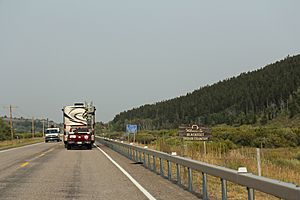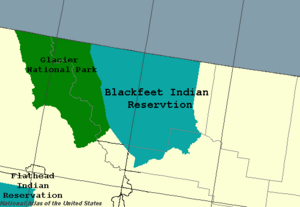Blackfeet Nation facts for kids
Quick facts for kids
Blackfeet Tribe of the
Blackfeet Indian Reservation of Montana Aamsskáápipikani, Pikuni
|
||
|---|---|---|
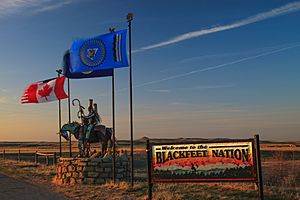
Northern boundary of the Blackfeet Tribe, Montana
|
||
|
||
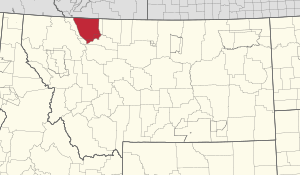
Location in Montana
|
||
| Tribe | Blackfoot (Niitsitapi) | |
| Country | United States | |
| State | Montana | |
| Counties | Glacier Pondera |
|
| Headquarters | Browning | |
| Government | ||
| • Body | Vern Timmerman | |
| Area | ||
| • Total | 2,285.4 sq mi (5,919.1 km2) | |
| • Fee lands | 827.85 sq mi (2,144.13 km2) | |
| Highest elevation | 9,066 ft (2,763 m) | |
| Lowest elevation | 3,400 ft (1,000 m) | |
| Population
(2017)
|
||
| • Total | 9,929 | |
| • Density | 4.34458/sq mi (1.67745/km2) | |
| Website | blackfeetnation.com | |
The Blackfeet Nation is a Native American tribe. It is officially called the Blackfeet Tribe of the Blackfeet Indian Reservation of Montana. They are part of the Blackfoot Confederacy, a group of four related tribes. Three of these tribes live in Canada. The Blackfeet Nation is the only one that lives in the United States.
The Blackfeet Indian Reservation is a special area of land set aside for the tribe. It is located in Montana, east of Glacier National Park. It also shares a border with the Canadian province of Alberta. The reservation covers about 3,000 square miles (7,800 km2). It is found in parts of Glacier and Pondera counties.
Contents
History of the Blackfeet Nation
In the 1600s, the Blackfeet tribe spoke an Algonquin language. They lived near the Great Lakes. British traders forced them to move from their homes. The Blackfeet then settled in the northwestern Great Plains region, which is now Montana.
The Blackfeet people moved around, following large herds of bison (buffalo). Bison were very important for their food, clothing, and homes. They used clever ways to hunt bison, like the "buffalo jump." At places like Head-Smashed-In Buffalo Jump, men would scare a herd of bison. They would chase some of the bison off a cliff. Other men would be waiting below to finish the hunt. The Blackfeet used every part of the bison.
Their homes were called Tipis. Tipis were perfect because they were easy to set up, take down, and carry. This was important since the tribe moved often. They built tipis using wooden poles and bison hides.
Blackfeet clothing was made from deerskin and bison hides. Chiefs wore tall feather headdresses to show their importance. Men wore breechcloths, leggings, and moccasins. Women wore long dresses decorated with fringes, beads, porcupine quills, and elk teeth.
In the 1800s, the Blackfeet got horses and firearms. This made hunting bison much easier. By this time, they controlled a huge area. It stretched from modern-day Edmonton, Alberta, almost to Yellowstone National Park. It also went from Glacier National Park to the Black Hills of South Dakota.
Later in the 1800s, European settlers made many Blackfeet move to smaller reservations. Only one of the four Blackfoot tribes settled in the United States. The Blackfeet have worked hard to protect their special sacred site, the Badger-Two Medicine area.
Geography of the Reservation
The Blackfeet Indian Reservation has different elevations. The lowest point is 3,400 feet (1,036 m) above sea level. The highest point is Chief Mountain at 9,066 feet (2,763 m). The eastern part of the reservation has open, rolling hills covered in grassland. Along the western edge, there is a narrow strip of forests with fir and spruce trees. You might see free-ranging cattle walking on the roads in many areas.
Several rivers flow through the reservation. These include the St. Mary River, Two Medicine River, Milk River, Birch Creek, and Cut Bank Creek. There are 175 miles (282 km) of streams and eight large lakes on the reservation.
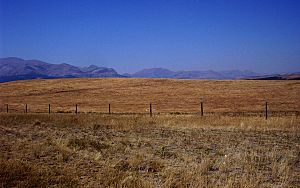
The reservation is located east of the Rocky Mountains in Montana. The Blackfeet call the Rocky Mountains the "Backbone of the World." They have given names to several peaks in these mountains. Some of these names are Morning Star, Poia, Little Plume, and Chief Mountain.
People and Communities
The 2020 census showed that 9,929 people live on the Blackfeet reservation lands. The Blackfeet Nation has 17,321 enrolled members.
The main community and the center of the tribal government is Browning, Montana. Other towns near Glacier National Park attract tourists. These include St. Mary and East Glacier Park Village. East Glacier Park Village has an Amtrak train station and the historic Glacier Park Lodge.
Smaller communities on the reservation include:
- Babb
- Heart Butte
- Kiowa
- Little Browning
- North Browning
- South Browning
- Starr School
Culture and Traditions
The Blackfeet tribe has a long history passed down through stories and spoken history. These stories tell about their special central place, the Badger-Two Medicine area. The Blackfeet believe this area is where their people and the world were created.
The Rocky Mountain Front near Birch Creek, which includes the Badger-Two Medicine area, is protected by the Treaty of 1896. This treaty gives Blackfeet tribal members the right to hunt, fish, and cut wood there. It also protects the spiritual and cultural uses of this important area.
In 2002, a large part of the Badger-Two Medicine area was recognized as a Traditional Cultural District. This means it is important for its history and culture. This recognition was very important to the Blackfeet people.
The Blackfeet Nation celebrates North American Indian Days every year. This is a big festival held on pow wow grounds near the Museum of the Plains Indian in Browning. It is a time for celebration and cultural sharing.
Economy and Jobs
The Blackfeet Reservation gets income from several sources. These include petroleum and natural gas leases from oil fields. Tourism is also important, with visitors coming to see the beautiful land and learn about the culture. Ranching and farming are also major parts of the economy. Many tribe members also work as wildfire firefighters.
Government of the Blackfeet Nation
In the past, Blackfeet bands were led by chiefs who made decisions for the tribe. Today, the Blackfeet Nation has its own government. It is called the Tribal Business Council. This council is elected by the people. For many years, Earl Old Person was a respected leader of the council and an honorary chief.
The Tribal Business Council provides many services to the people living on the reservation. These services include courts, help for children, job support, wildlife management, health care, education, land management, and services for seniors. They also manage things like garbage collection and water systems.
Transportation
There are no paved roads that go north and south through Glacier National Park. To get to the east side of the park, vehicles use U.S. Route 89. This highway runs through the Blackfeet Reservation and crosses into Canada near Chief Mountain. In Canada, the park is called Waterton Lakes.
Two other routes run east and west across the reservation. The Amtrak train Empire Builder also travels through the reservation. There are several hiking trails that go from the park onto the reservation. People who do not live on the reservation need a permit from the Blackfeet Nation to hike these trails.
Notable Blackfeet People
- Elouise P. Cobell (1945–2011) was a tribal treasurer. She found that the U.S. government had not managed trust land fees correctly. She filed a lawsuit and won $3.4 billion for the reservation.
- Richie Havens (1941–2013) was a famous singer-songwriter and guitarist.
- Joe Hipp (born 1962) is a professional boxer.
- Stephen Graham Jones (born 1972) is a well-known author.
- Rickey Medlocke (born 1950) is a guitarist for the bands Blackfoot and Lynyrd Skynyrd.
- Earl Old Person (1929-2021) was a tribal chief and important political leader.
- Steve Reevis (1962–2017) was an actor who appeared in movies like Fargo.
- Misty Upham (1982–2014) was also an actor.
Interesting Facts About the Blackfeet Nation
- It is believed the Blackfeet got their name because their moccasins would turn black from stamping out campfires.
- The doorways of Blackfeet tipis always faced east.
- When the Blackfeet started using horses, they could pull larger items. This allowed them to make their tipis bigger.
- The Blackfeet decorated their clothing and tipis with paint, beads, and animal teeth.
- The Blackfeet used different styles of body-painting for different activities, such as war, religious ceremonies, and celebrations.
- The Sun Dance is a very important spiritual ceremony for the Blackfeet.
- Important men in the tribe would sometimes wear a bear-claw necklace.
- One way the Blackfeet hunted bison was to scare a herd and chase them toward a cliff. Men would wait at the bottom to prepare the bison for use.
- Sometimes, Blackfeet bands had two chiefs: a war chief and a civil (social) chief.



